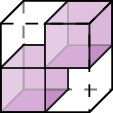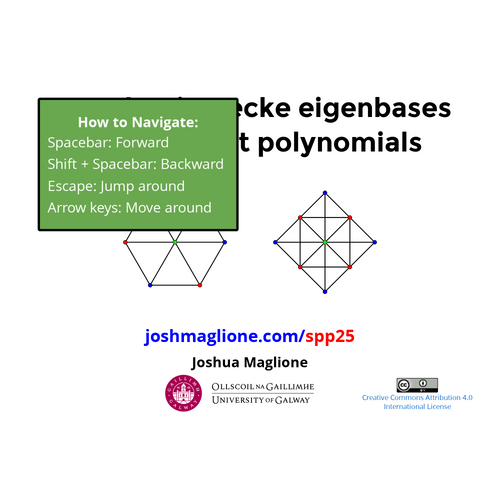Simultaneous Sylvester Systems & Symmetries
Joshua Maglione
joshmaglione.com



A related quantum problem
A qubit (quantum bit) is modeled by \(q \in\mathbb{C}^2\) via spin of electron:
Measuring a qubit:
(simplified!)
Logical gates (e.g. NOT, AND, OR) modeled by unitary group:
System of qubits \(q_1,\dots, q_n\in\mathbb{C}^2\) contained in the Hilbert space
System \(|\Phi\rangle\in \mathbb{C}^{2^n}\) not entangled if written as \(|\Phi\rangle = q_1\otimes \cdots \otimes q_n\).


front
front
back
back
multi-way array
Problem. Understand when two systems \(|\Phi\rangle, |\Psi\rangle\) equivalent:
LU-equivalent: \(\exists X_1,\dots, X_n\in \mathrm{U}_2\) such that
SLOCC-equivalent: \(\exists X_1,\dots, X_n\in \mathrm{SL}_2\) such that
(same condition as above)
A nearly identical problem exists in algebra


&
are LU- and SLOCC-inequivalent
Nilpotent groups & tensors
Nilpotent group \(G\) of class \(c\):
\(G = \gamma_1(G) \supset \gamma_2(G) \supset \cdots \supset \gamma_c(G) \supset \gamma_{c+1}(G) = \{1\}.\)
Important operation: commutator \([\cdot,\cdot]: G\times G \to G\) via
Recursively define: \(\gamma_1(G) = G\) and for all \(k\geqslant 1\),
Lower central series terminates:


Commutator yields a product:
a \(\Z\)-bilinear map
Problem. Given two class \(2\) nilpotent groups \(G,H\):
Isomorphism: \(\exists X_1\in\mathrm{GL}_r(\Z), X_2\in\mathrm{GL}_s(\Z)\) such that
Automorphism: \(\exists X_1\in\mathrm{GL}_r(\Z), X_2\in\mathrm{GL}_s(\Z)\) such that
(same condition as above with \([\cdot,\cdot]_G\))

Tensor Isomorphism
Both problems special cases of tensor isomorphism

multi-way arrays
bilinear maps
Given two \(K\)-tensors \(s, t : V_1\times \cdots \times V_n \to V_0\) decide if \(s\) equals \(t\) after a change of bases in \(V_i\) for all \(i\).
Goal: see how algebras associated to tensors help.
Groups from elliptic curves
Joint with Mima Stanojkovski (arXiv:2212.03941)
From \(E\) and \(P\) build \(3\times 3\times 3\) tensor:
Group scheme
over \(\Z\)
Elliptic curve


linear determinantal
representation
Build a group from \(t : U\times V \to W\), due to Baer (more general).
Define \(G_t = U\oplus V\oplus W\) with multiplication:
Important feature: the commutator tensor of \(G_t\) is
Lots of class 2 nilpotent groups arise this way:
- (infinite) finitely generated, torsion-free groups,
- (finite) groups \(G\) such that for some prime \(p\), \(g^p=1_G\) for all \(g\in G\).
Problems:
- For ring \(R\), when is \(\mathbf{G}_{E, P}(R) \cong \mathbf{G}_{E',P'}(R)\)?
- Decide in polynomial time if \(G \cong \mathbf{G}_{E, P}(\mathbb{F}_q)\).
For rings \(R\) with \(2^{-1}\in R\),
where \(t : R^3\times R^3 \to R^3\) from \((E, P)\).
These boil down to instances of the tensor isomorphism problem.
Use algebras associated to tensors to reduce the complexity.
Adjoint algebra
Suppose \(t : U\times V \to W\) is a \(K\)-tensor.


tensor
evaluation
Equality \(t(Xu, v) = t(u, Yv)\) implies equality on each slice


\(\displaystyle\left\{\phantom{\sum_{k=0}^n}\right.\)
\(\displaystyle\left\{\phantom{\sum_{k=0}^n}\right.\)
\(\displaystyle\left\{\phantom{\sum_{k=0}^n}\right.\)
\(\displaystyle\left\{\phantom{\sum_{k=0}^n}\right.\)
Ignore \(u\) and \(v\), so the linear system for \(\mathrm{Adj}(t)\) is a Sylvester system:
Sylvester equation
What's the point (of adjoints)?
For \(t : U\times V\to W\), the \(\mathrm{Adj}(t)\) contains structural information.
Certain elements of \(\mathrm{Adj}(t)\) yield change of bases into nice forms:



dense tensor
perp-space
decomposition
isotropic
subspaces
Assume \(V=U\) and \(t(v,v) = 0\) for all \(v\in V\)
For group schemes coming from geometry, e.g. our construction:
this "isotropic decomposition"

Group scheme
over \(\Z\)


always exists and can be constructed in polynomial time.
Useful for recognition: is my group one of those groups?

Centroids & Coefficients
Many different algebras associated to tensors.
The centroid of \(t : U \times V \to W\) is
Like with the adjoint algebra, centroid gives structural information.


Certain elements in \(\mathrm{Cent}(t)\) can decompose tensor:
Satisfies universal property: largest ring \(C\) such that \(t\) is \(C\)-bilinear.
Example: \(t\) starts as \(\mathbb{Q}\)-bilinear, but \(\mathrm{Cent}(t)\) is a field extension.
Let \(t : \mathbb{Q}^2 \times \mathbb{Q}^2 \to \mathbb{Q}^2\) with multi-way array:
Writing \(t\) over \(K = \mathbb{Q}(\sqrt{17})\), we have \(s : K \times K \to K\) given by
Deciding isomorphism
Back to groups coming from elliptic curves
Previously, it was \(O(n^{\log n})\), where \(n=|G|\) -- this is brute force.
Using just the centroid, there is a \(O(|G|)\)-algorithm.
Goal: a polynomial-time algorithm in \(\log|G|\), size of input.
Theorem (M--Stanojkovski). There exists an algorithm that, given a finite group \(G\), decides if there exist
- prime power \(q\),
- \(a,b\in\mathbb{F}_q\) such that \(y^2 = x^3 +ax+b\) defines an elliptic curve \(E\),
- \(P\in\mathbb{F}_q^2\) on \(E\) (i.e. satisfies the equation),
such that \(G\cong \mathbf{G}_{E, P}(\mathbb{F}_q)\) using \(O(q) = O(|G|^{1/9})\) operations.
Algorithm








From a group, get commutator tensor \(t : V\times V \to W\).
Use centroid and adjoint to distill to essential information:
Then work to get geometric data -- find the point \(P\) (bottleneck).
A Magma implementation
We beat previous algorithms by huge margins, despite not poly-time.
EGroups package publicly available.

Ongoing work: Sylvester
These are bottlenecks for many other algorithms
For \(d\times d\)-matrices \(A_i, B_i, C_i\), with \(i\in \{1,\dots e\}\), set
and solve for \(X\) and \(Y\).
System of \(d^2e\) equations in \(2d^2\) variables, not sparse \(\leadsto\) \(O(d^6)\) time.
Joint with Chris Liu and James B. Wilson
We believe we have an algorithm that runs in \(O(d^{3.5})\) time.
Julia implementation
(prototype!)


Compared a Julia implementation vs. old Magma implementation.
For each \(i\in \{1,\dots, e\}\), each \(A_i, B_i, C_i\) is a \(d\times d\)-matrix:
\(e= d\)
\(e= \sqrt{d}\)
Future work: QIT
With Robert Zeier from the Jülich Research Center, we are exploring ways to reduce the complexity either by
In QIT, need structural information from the entangled systems.
To get this, solve massive simultaneous Sylvester systems.
Involve tensors will lots of factors:
Analyzing actions of unitary groups and their Lie algebras.
- bringing in algebraic tools similar to the adjoint algebra, or
- solving the particular simultaneous Sylvester systems faster.
Simultaneous Sylvester system & symmetries
By Josh Maglione
Simultaneous Sylvester system & symmetries
- 623




